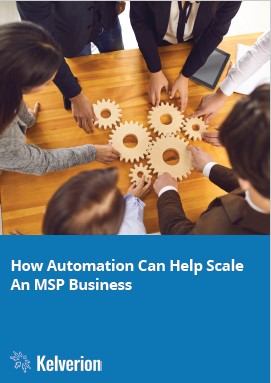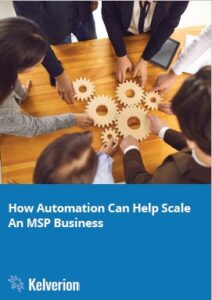How Automation Can Help Scale An MSP Business
How Automation Can Help Scale An MSP Business
Introduction – MSP Automation For Business Growth
For a Managed Service Provider (MSP) to grow, it must win new customers.
However, each new customer brings more devices and users that require management, incident ticket resolution, and provisioning.
If the above is actioned manually, an MSP requires dedicated staff to handle the new clients’ users, devices, resolve tickets and requests.
Bearing in mind, each staff member can only support a certain number of users and devices. These tasks contribute to a significant amount of time-consuming and repetitive work.
While these challenges are not unique to MSPs and are also encountered by enterprises with internal IT functions, MSPs face them on a much larger scale as they handle multiple customers simultaneously, often with strict service level agreements (SLAs) to meet.
The great news is that there are automation solutions available to streamline and automate these time- consuming and mundane tasks.
MSP Automation refers to the implementation of automated processes within a Managed Service Provider (MSP) environment.
What is MSP Automation?
MSP Automation provides the tools to capture, model, and execute processes in automated workflows. These automated processes seamlessly integrate with existing systems such as Service Desks, Enterprise Management tools, email, databases, monitoring tools, logs, file systems, and native operating system functions. This enables the rapid construction and deployment of automated processes within the MSP environment.
The key objective is to simplify the complexity of IT operations by aligning them with straightforward business practices. Through a Self-Service Portal, users can request any IT task needed to be undertaken.
Automation picks up the request, integrates with the Service Desk for approval (logging the request if required), and executes the requested task on behalf of the user.
MSP Automation allows you to delegate tasks that are typically complex or require high-level access, to anyone in your business including your customers.
By implementing your desired business processes, standard requests can be automated at scale and across multiple customers. This automation relieves your staff from repetitive manual fulfillment tasks, enabling them to concentrate on crucial activities such as onboarding new customers and developing new services.
By automating these standard requests and freeing up your staff’s time, MSPs can effectively service more customers with the same workforce. This approach helps flatten out headcount growth and ensures a sustainable balance between revenue, staff costs, and profit margin.
The increased efficiency and productivity achieved through automation enables an MSP to handle a larger customer base without proportionally increasing the staff count. This leads to improved scalability, cost-effectiveness, and, ultimately, higher profitability.
Not only can MSPs service more customers through automation, but this approach also provides with a significant business advantage over competitors who have not embraced automation. By automating processes, MSPs can offer faster service, maintain a lower cost base, and be more competitive on price without sacrificing profit margins.
Furthermore, automation allows MSPs to enhance their service offering to customers, providing improved efficiency and reliability.
Top Use Cases MSPs Are Looking to Automate
When it comes to the top use cases that MSPs are looking to automate, we conducted a recent survey involving over 380 individuals from 350 different organizations and MSPs worldwide.
The survey aimed to identify the specific targets they are looking to automate. Here are the results of the survey:
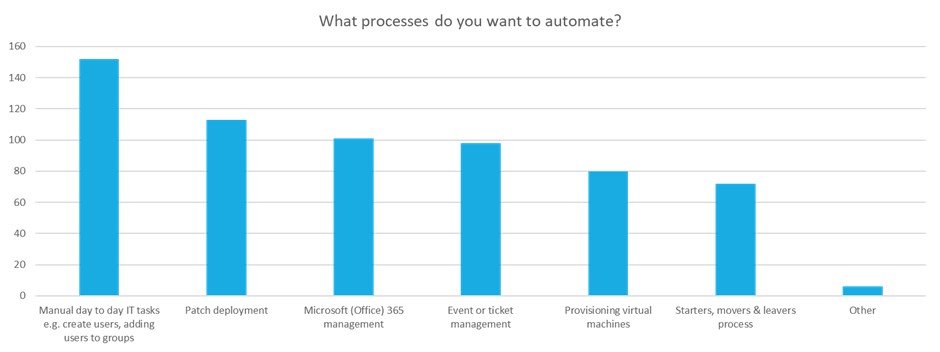
Among the various use cases, MSPs were particularly focused on four key areas:
- Standard IT Tasks
- Microsoft 365 Management
- Starter, mover, leaver processing
- Ticket Management
These are explored in more detail below.
Standard IT Tasks
Automating manual day-to-day tasks:
MSPs recognized the need to automate routine tasks that are typically performed manually by IT staff. Even if the workload is manageable, these repetitive tasks can have a negative impact on team morale and productivity.
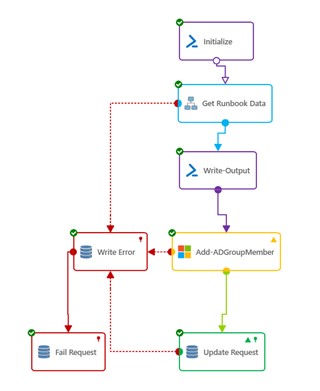
By automating tasks such as adding users to Active Directory Groups, starting or stopping virtual machines, conducting diagnostic actions like ping or traceroute checks, and performing remediation actions like service restarts, these standard daily tasks can all be easily automated.
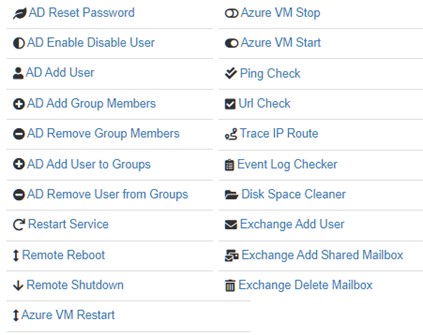
Microsoft 365 Management
Microsoft 365 saves companies the headaches of operating Exchange, SharePoint, and Teams infrastructure.
However, the management of users and permissions is still time-consuming, from creating users to adding users to groups, assigning a license, to disabling a user.
Microsoft 365 Management requires senior staff who have the necessary admin access and expertise to perform.
Automation of these tasks relieves pressure on MSPs.
The key is to provide a self-service interface for anyone to submit requests, controlled via an existing change management approval process; the automation platform executes the Microsoft 365 Management requests automatically in minutes.
The benefit is that now staff don’t need administration-level access to Microsoft 365 or to understand how the UI operates; they just complete simple request forms, and automation does the rest.
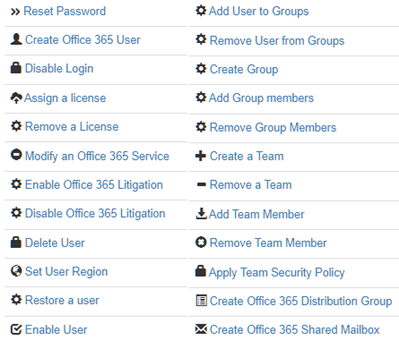
Starters, Movers, Leavers
Starters, movers, and leavers processes pose significant challenges for overloaded managed service providers. Tasks such as creating accounts for new employees or temporary workers, adjusting access for users transitioning to new roles, and terminating IT accounts for those leaving a company are labor-intensive activities. These tasks require the expertise and systems access of senior staff members.
The manual fulfillment of these tasks often leads to delays, which can have severe business impacts. New employees may not have the necessary access they require, causing productivity issues, while the failure to promptly remove user access when someone leaves an organisation can result in security risks.
To address these challenges, a self-service interface is utilized, allowing the personnel department or line managers of the customer to submit requests for onboarding or offboarding individuals.
The automation platform then seamlessly executes all the necessary IT actions associated with SML processes automatically within minutes. This eliminates delays and ensures that the required tasks are performed accurately and efficiently.

Ticket Management
In the realm of event or ticket management, a notable focus is on automating the creation and handling of incident tickets triggered by alerts detected by monitoring tools. This automation streamlines the entire process, ensuring smooth workflow synchronization when tickets are resolved.
Moreover, it extends to automating the diagnostic procedures for these tickets and even the remediation of basic issues. By automating these routine tasks, IT staff members are freed from manual break/fix tasks, enabling them to allocate more time to root cause analysis and strategic problem-solving rather than constantly dealing with operational fixes. This shift in focus allows for more efficient and proactive IT management.

Multitenancy For MSP Automation
When it comes to managing multiple customers, multitenancy support is crucial for the sustainability of an MSP. By utilizing a multitenancy system, MSPs can have a single instance of the software and infrastructure that serves multiple customers, known as “Tenants.” While each Tenant remains logically separate, they are physically connected to the same underlying infrastructure. This approach allows MSPs to have a unified management platform and methodology to efficiently meet the needs of numerous customers. It accelerates deployment, reduces costs, and establishes a repeatable model for service delivery.
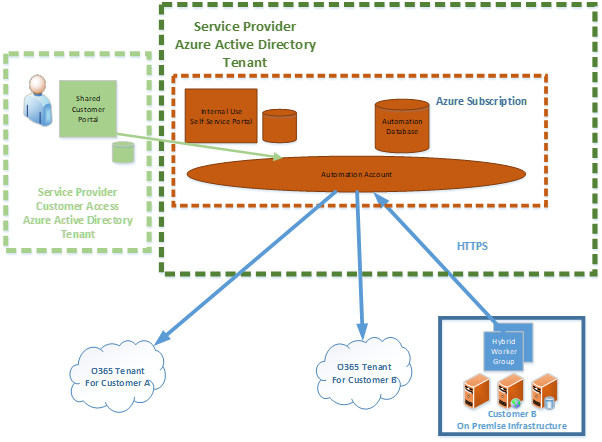
Kelverion’s automation offering provides comprehensive multitenancy support, featuring a shared self-service portal and a centralized automation platform. This platform enables MSP automation the infrastructure of multiple customers, whether they are utilizing cloud services or on-premises resources. The Kelverion solution operates within Microsoft Azure, leveraging its security capabilities to ensure the logical separation of individual customers on the shared self-service and automation platform. This arrangement provides enhanced security and efficiency for managing multiple customers within a unified and scalable environment.
Equally, if there is a larger customer who wants a dedicated automation environment, then the same automation platform architecture can be deployed for individual customer use.
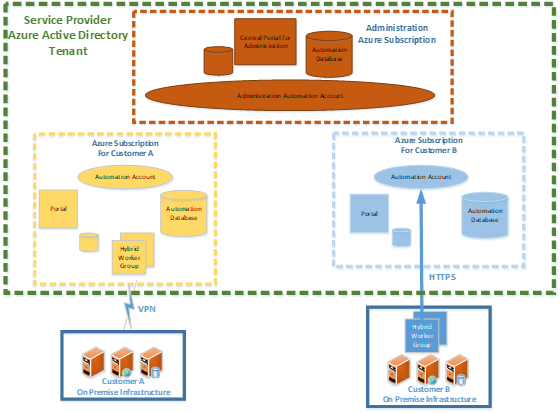
Conclusion
Implementing MSP Automation involves integrating automation and self-service capabilities into existing systems and processes rather than replacing them entirely with new tools and systems. The objective is to automate standard requests on a large scale and across multiple customers, enabling staff members to be freed from repetitive manual tasks and instead focus on onboarding new customers and developing new services.
With MSP automation, users are not required to have IT administration rights, as the automation system controls and executes the necessary actions. This approach empowers all users by providing them with the ability to perform tasks for themselves and on behalf of others.
The ultimate goal is to enhance efficiency and empowerment within the MSP environment. By automating tasks and enabling self-service, MSPs can effectively serve a larger customer base without significantly increasing their staff count. This approach contributes to flattening out headcount growth and establishing a sustainable balance between revenue, staff costs, and profit margins.
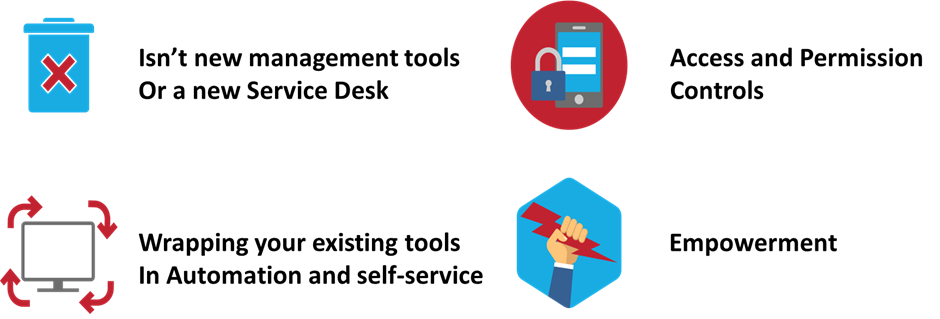
About Kelverion
Experts in Cloud, On-Premise and Hybrid automation, Kelverion provide solutions and integrations that remove the manual process tying up IT staff; transforming the productivity, efficiency, and supportability of IT automation. Our products utilise and enhance the power of Microsoft Azure and System Center Orchestrator.
Working closely alongside Microsoft we have developed our integrations and automation solutions to help bridge the gap between Microsoft’s automation platforms and third-party systems, in the process building key alliance partnerships with multiple vendors to ensure our products are fully certified.
Since 2010, Kelverion has expanded to become a global company, with offices now in the UK, Canada, and the US. Through this, we are able to offer and support products and professional services engagements to enterprise-level organisations no matter where they are.
There’s a smarter approach to IT Service Management with MSP Automation
Get in touch to find out more
info@kelverion.com | US Tel: +1 289 801 0559 | UK Tel: +44 203 875 8035

